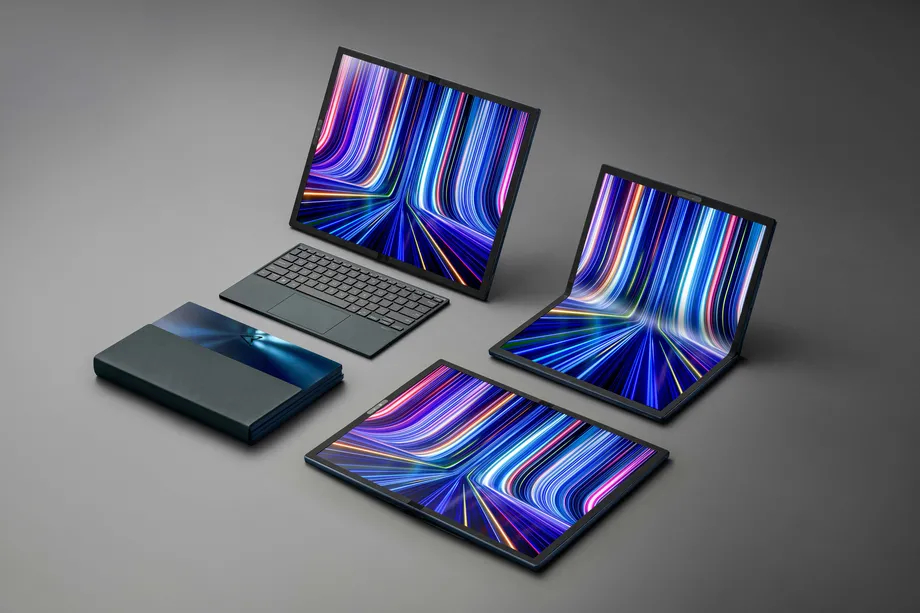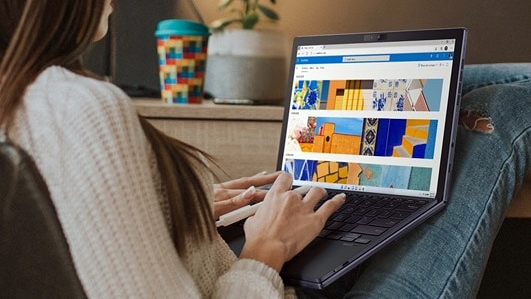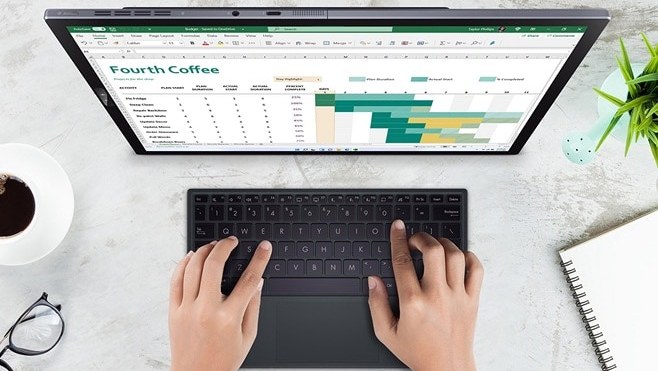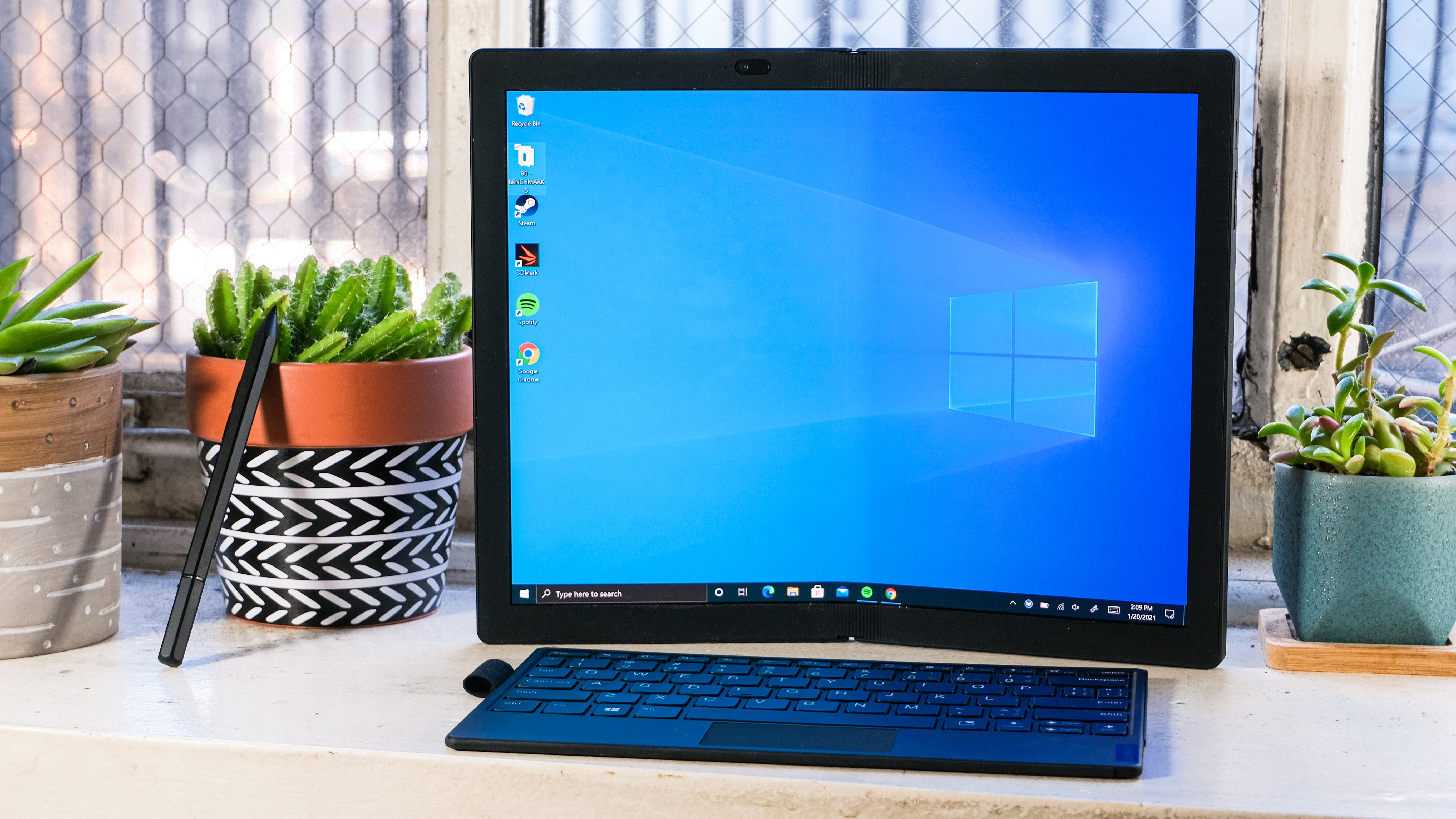CES 2022 gave us a peek at our foldable laptop future – and I can’t wait
Goodbye, clamshell!

Asus pitches the Zenbook 17 Fold OLED as being usable in more positions than traditional laptops.
(Image credit: Asus)CES 2022 is over, and while the show was a little more low-key than usual this year thanks to some last-minute COVID-19 complications, computing enthusiasts still got some exciting news about the year ahead.
We got a look at Intel’s first batch of 12th Gen laptop CPUs, which will start showing up in laptops later this year. Intel claims the leading chips in this lineup can outperform Apple’s M1 Max, which is exactly what they need to do after Apple blew us away last year with the performance of the M1 Pro and M1 Max chips in its MacBook Pro 2021.
Intel’s cutting-edge chips should help deliver unprecedented performance in Windows laptops shipping this year, and we got a preview of what that will look like at CES 2022. From big, beefy gaming laptops like the Acer Predator Helios 300 to ultra-thin machines like the Asus ROG Flow Z13 and Dell XPS 13 Plus, there’s a lot of exciting hardware hitting stores this year.

Personally, I’m most excited about the promise of the Asus Zenbook 17 Fold OLED. Unveiled at CES 2022, this futuristic laptop (pictured above) is essentially a 17.3-inch OLED touchscreen you can fold in half. When unfolded, the display should be pretty big and bright, delivering 2,560 x 1,920 pixels in a 4:3 aspect ratio at up to 500 nits (according to Asus) of brightness. Fold it up into a clamshell configuration and the upper half becomes a 12.5-inch 1080p screen with a 3:2 aspect ratio, while the bottom half can display a virtual keyboard. And if the thought of typing out emails on a touchscreen sounds miserable to you, Asus offers an alternative – an ErgoSense Bluetooth keyboard with built-in touchpad that’s designed to sit on top of the lower half of the Fold when you’re using it like a traditional laptop.
Of course, you can also prop the screen up with its built-in kickstand and set the keyboard somewhere that’s comfortable to type on, allowing you to utilize all of the Fold’s screen real estate while working with it in all sorts of different laptop/tablet hybrid configurations.

It ought to be a pretty speedy laptop too, as the Zenbook 17 Fold will ship with the latest Intel 12th Gen Core i7 U-series CPUs, 16GB of RAM and a 1TB NVMe SSD for storage. With just a pair of Thunderbolt 4/USB-C ports and a headphone jack it won’t be the most versatile laptop we see in 2022, but hopefully the 75WHr battery will give it enough juice to last at least eight hours or so on a full charge. We’ll find out later this year, though Asus still hasn’t announced pricing or any release date details more specific than Q2 2022.
But even if the Fold ends up being a bust, I’m excited it exists because of what it augurs for the future of laptops. Sure, right now foldable screens still have significant weaknesses: Android phones have had them for years, yet even the best foldable phones (like the Samsung Galaxy Z Fold 3) tend to be overly expensive and underpowered. The foldable laptop market is far less developed; Lenovo took a big swing releasing its ThinkPad X1 Fold, the world’s first foldable laptop, and as cool as it was it was also an underpowered battery hog that cost too much (starting price: $2,500).

The ThinkPad X1 Fold launched in late 2020, and since then we haven’t heard much about the future of foldable laptops. But at CES 2022 this vision of a more flexible, beautiful future for PCs got a shot in the arm thanks to both the unveiling of the Zenbook 17 Fold and a slew of foldable screen concept demos from Samsung Display. Samsung Display is the industry leader in foldable screen tech, and its Flex Note concept is especially intriguing because it (like the Zenbook 17 Fold) is essentially a 17.3-inch touchscreen that can fold into a 13-inch laptop.
Lots of laptop makers source screens from Samsung Display, so it’s likely we’ll start seeing more foldable laptop designs hitting the market in the years ahead as Samsung fine-tunes the tech and entices OEMs into designing laptops around it. Intel will also be helping to push the development of foldable laptops forward with its Intel Evo platform, which is basically a set of guidelines on what Intel expects from a “premium” Intel-powered laptop. Laptops that meet all the guidelines can be marketed with Intel Evo branding; you’ve probably seen it on the little stickers you peel off your laptop after you buy it.
Intel announced the third iteration of its Evo platform at CES 2022, and among the new additions is a set of specifications for Intel Evo laptops with foldable displays. Intel says it expects a number of foldable laptop designs to pass the Intel Evo verification process this year, which is the best indicator I’ve seen yet that foldable laptops are becoming a reality after years of being just a weird, bendy pipe dream.
Personally, I can’t wait. Sure, foldable screens seem like a silly gimmick. Laptops don’t need them to be quality products, and I expect the first few years of foldable laptops will be riddled with expensive designs that make too many compromises for too little benefit; we saw something similar play out in the foldable phone market over the past few years.
But now foldable phones are starting to seem durable, powerful, and affordable enough to be worthwhile. I’m an iOS man at the moment, but every time I see a Samsung Display demo or hear about one of my colleagues reviewing a new Samsung foldable (because it sure seems like everyone but Samsung sucks at foldable phones), I get a little jealous. I start wondering if it’s time to go back to Android. But mostly, I think about how cool it would be to have a big, beautiful screen I could fold up and slip in my pocket.
It will probably be a while before we see foldable laptops you can fit in your pocket, of course — unless you wear the biggest, most ‘90s cargo pants on the planet, that future is still probably a few years away. But the prospect of having a 17-inch OLED ultraportable I can fold up and slip into a shoulder bag later this year feels positively futuristic. Sure, the Asus Zenbook 17 Fold OLED probably won’t be the best example of an ultraportable foldable, as it’ll weigh about 3.6 pounds – and that’s before you factor in the extra bulk of a Bluetooth keyboard. But at less than half an inch thin it should be a pretty svelte device, and its arrival later this year will be a big step forward into what's looking more and more like a glorious foldable laptop future.
In other foldable laptop news, HP is reportedly working on its own foldable laptop that may launch as early as the end of 2022. We don't have official word on that particular story, but it's another sign that we'll see more foldable notebooks in the future.
Sign up to get the BEST of Tom's Guide direct to your inbox.
Get instant access to breaking news, the hottest reviews, great deals and helpful tips.

Alex Wawro is a lifelong tech and games enthusiast with more than a decade of experience covering both for outlets like Game Developer, Black Hat, and PC World magazine. A lifelong PC builder, he currently serves as a senior editor at Tom's Guide covering all things computing, from laptops and desktops to keyboards and mice.

